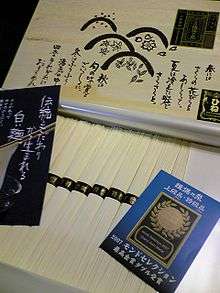Sōmen
|
Sōmen (in large white bowl at upper-right) with assorted toppings | |
| Type | Japanese noodles |
|---|---|
| Place of origin | Japan |
| Serving temperature | Cold |
| Main ingredients | Noodles (wheat flour) |
|
| |
Sōmen (素麺) are very thin white Japanese noodles made of wheat flour, less than 1.3 mm in diameter. The noodles are usually served cold. The noodles' diameter is the chief distinction between sōmen and the thicker wheat noodles hiyamugi and Japanese wheat noodles udon. Sōmen noodles are stretched when made, as are some types of udon noodles. The dough is stretched with the help of vegetable oil to make very thin strips and then air dried.
Sōmen are usually served cold with a light flavored dipping sauce[1] or tsuyu. The tsuyu is usually a katsuobushi-based sauce that can be flavored with Japanese bunching onion, ginger, or myoga. In the summer, sōmen chilled with ice is a popular meal to help stay cool.
Sōmen served in hot soup is usually called "nyumen" and eaten in the winter, much as soba or udon are.
Nagashi-sōmen


Some restaurants offer nagashi-sōmen (流しそうめん flowing noodles) in the summer. The noodles are placed in a long flume of bamboo[2] across the length of the restaurant. The flume carries clear, ice-cold water. As the sōmen pass by, diners pluck them out with their chopsticks[2] and dip them in tsuyu. Catching the noodles requires a fair amount of dexterity, but the noodles that are not caught by the time they get to the end usually are not eaten, so diners are pressured to catch as much as they can. A few luxury establishments put their sōmen in real streams so that diners can enjoy their meal in a beautiful garden setting. Machines have been designed to simulate this experience at home.
See also
References
- ↑ Hiking in Japan - Richard Ryall, Craig McLachlan, David Joll. p. 177.
- 1 2 Adika, Alon (September 21, 2013). "Tsushima: a boundary island of Japan". The Japan Times. Retrieved 19 October 2013.
External links
 Media related to Somen at Wikimedia Commons
Media related to Somen at Wikimedia Commons
